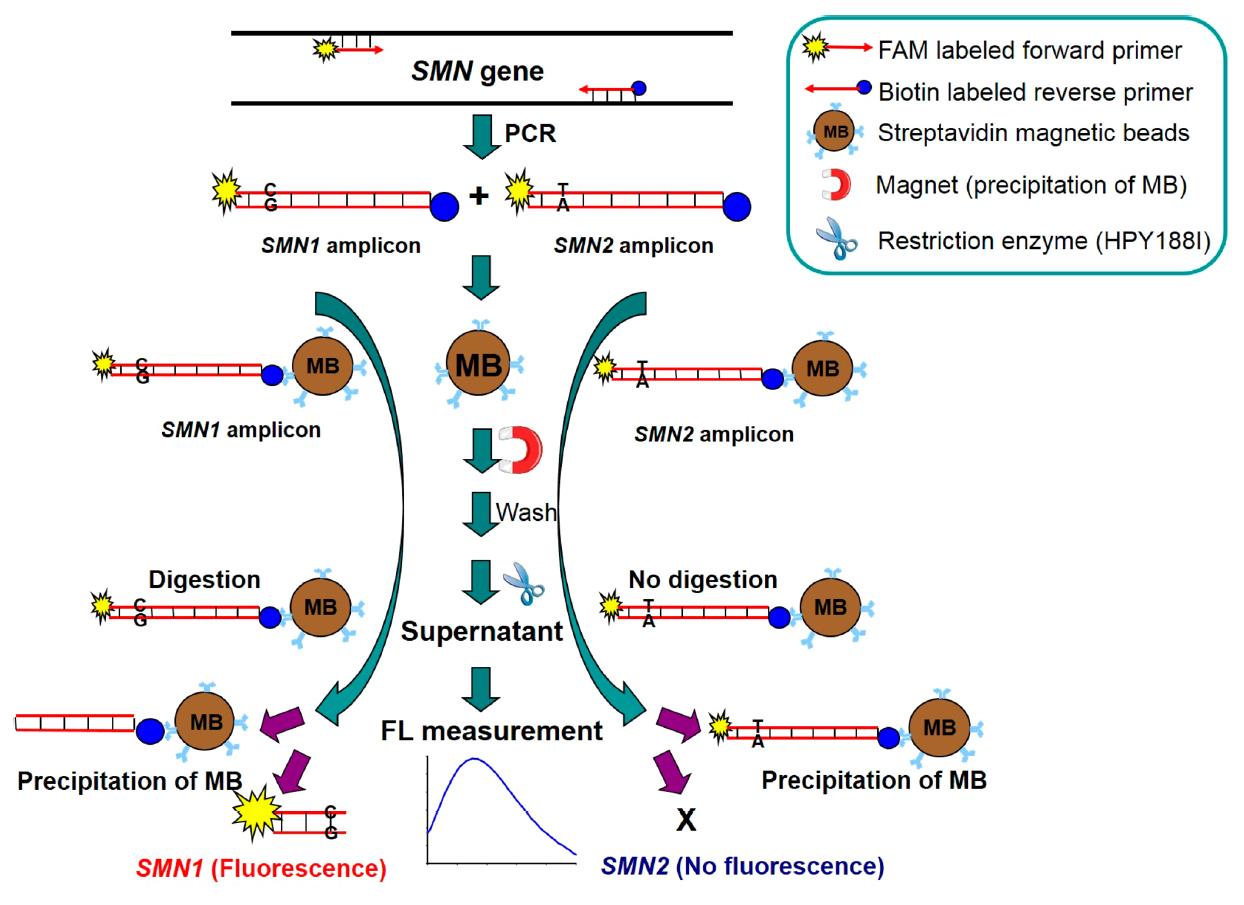建立快速螢光檢測平台應用於診斷人體基因變異
建立快速螢光檢測平台應用於診斷人體基因變異
近幾年來,大眾開始對健康與預防醫學的重視,而使得【基因檢測】成為相當重視的國家發展主題與學術研究項目。自2000年人類基因體計畫完成以來,越來越多的基因功能被解讀成功,已超過2000種基因相關疾病被發現,如今已有700多種基因相關疾病已開發出相應藥物及治療方法,且癌症與許多罕見疾病。基因檢測是偵測染色體結構中之DNA序列是否發生變異位點或基因表現程度,提供受檢者與醫療研究人員評估一些與基因遺傳有關的疾病、體質或個人特質的依據,也是精準醫學分析的一種方法。每一個人的DNA基因都是獨特的個人化資訊,造成每一個人的先天體質,健康狀況,特徵都不相同;2008年,美國時代雜誌曾經把這個革命性技術評選為2008年度最佳創新之首。
而現行基因檢測技術經常需要使用到一些昂貴耗材或大型儀器,使得檢測費用較高 (約2000-5000元等),且須時數日至數週,因此並非所有實驗室皆可完成之檢驗技術,而為了使基因檢測技術更簡單、方便、準確且快速,本研究開發一『快速應用螢光於基因變異檢測之技術』,應用於分析運動神經元存活基因(survival motor neuron gene,簡稱SMN)以診斷脊髓肌肉萎縮症(spinal muscular atrophy,簡稱SMA)。
脊髓肌肉萎縮症為一種先天遺傳的疾病,造成病患肌肉無力且萎縮,輕症者行動不便,重症者則會因呼吸衰竭而死亡。現行已知運動神經元存活基因為控制此疾病之基因,於懷孕初期診斷該基因可96%預防此疾病發生或進行即早治療,因此該基因檢測已是懷孕婦女必檢測之基因項目之一。目前為止,臨床上有數種方法可用來診斷該基因,包括有限制酶酵素分解法(RFLP),real-time PCR方法、denatured HPLC (DHPLC),毛細管電泳法、質譜分析法或Multiplex Ligation-dependent Probe Amplification (MLPA)等,但該些方法就如同前述的傳統基因分析方法,分析耗時且需要一些昂貴耗材或大型儀器。而本研究為使基因檢測更加簡單且快速,設計一快速螢光基因檢測平台,其原理如圖形摘要所示,僅須於引子對修飾Biotin基團與螢光基團,另搭配磁珠基因捕捉與純化,最後用限制酶酵素將捕捉基因片段進行剪切,即可應用螢光的強弱變化,了解該運動神經元存活基因為何種基因型。此方法方便、簡單且快速,且該方法具有通用性,只要選擇適當的限制酶酵素即可應用於不同基因之檢測,相當地適合應用於分析各種不同類型的基因變異。
圖形摘要

應用與亮點:
1.基因檢測是偵測染色體結構中之DNA序列是否發生變異位點或基因表現程度,提供受檢者與醫療研究人員評估一些與基因遺傳有關的疾病、體質或個人特質的依據,也是精準醫學分析的一種方法。
2.本研究開發一『快速應用螢光於基因變異檢測之技術』,應用單純螢光強弱於分析運動神經元存活基因(survival motor neuron gene,簡稱SMN)以診斷脊髓肌肉萎縮症(spinal muscular atrophy,簡稱SMA)。
3. 此方法方便、簡單且快速,且該方法具有通用性,只要選擇適當的限制酶酵素即可應用於不同基因之檢測,相當地適合應用於分析各種不同類型的基因變異。
【研究團隊】
團隊成員:王俊棋、陳俊安、鐘育志、柯黃盛
代表單位:高雄醫學大學 藥學系
團隊簡介:
該研究團隊長年來致力於毛細管電泳法、藥物分析、基因分析、特殊探針及引子設計、奈米粒子合成及應用等,已開發出多項藥物監測或基因檢測之技術,且獲得多項專利。
研究聯繫Email:chunchi0716@kmu.edu.tw
【論文資訊】
論文出處:Analytical Chemistry 2018, 90(19): 11599–11606.
全文下載:https://pubs.acs.org/doi/10.1021/acs.analchem.8b02996
Development of Fast Fluorescent Genotyping Platform for Detection of Nucleotide Variants in Human Genes
Development of Fast Fluorescent Genotyping Platform for Detection of Nucleotide Variants in Human Genes
In recent years, the public has begun to attach importance to health and preventive medicine, which has made genetic testing become a national development theme and academic research project. Since the completion of the Human Genome Project in 2000, more and more gene functions have been successfully interpreted, and more than 2,000 gene-related diseases have been discovered. Today, more than 700 gene-related diseases have been developed with corresponding drugs, treatments, cancer and many rare diseases. Genetic testing is to detect whether the mutation sites of the DNA sequence in the chromosome structure or the degree of gene expression, which provides the information for medical researchers to evaluate some diseases, physiques or personal characteristics related to genetic inheritance. Genetic testing is also a part of the precision medicine. Everyone's DNA genes are unique and personalized information, which causes everyone's innate physique, health status, and characteristics. In 2008, the American Time magazine selected this revolutionary technology as the top innovation of 2008.
The current genetic testing technology often requires the use of some expensive consumables or large-scale instruments, which makes the testing cost high, and takes several days to several weeks. Therefore, not all laboratories can complete the testing technology. In order to make the gene detection technology simpler, more convenient, accurate and fast. This research has developed a technique for rapid application of fluorescence in gene mutation detection, which is applied to analyze survival motor neuron gene (SMN) for diagnosis of spinal muscular atrophy (SMA).
SMA is a congenital genetic disease that causes muscle weakness and atrophy in patients. People with mild disease have inconvenience in mobility, and those with severe disease will die due to respiratory failure. The SMN gene that controls this disease has been known. Diagnosing this gene in the early stages of pregnancy can prevent the disease from occurring 96% or provide immediate treatment. Therefore, this gene testing is one of the genetic items that must be tested for pregnant women. So far, there are several clinical methods for diagnosing this gene, including restriction enzyme digestion (RFLP), real-time PCR, denatured HPLC (DHPLC), capillary electrophoresis, mass spectrometry or multiplex ligation-dependent probe amplification (MLPA), etc., but these methods are just like the aforementioned traditional genetic analysis methods. These analyses are time-consuming and require some expensive consumables or large instruments. In order to make gene detection simpler and faster, this study designed a fast fluorescent gene detection platform. The principle is as shown in the summary. Only the primer pair needs to modify with the biotin group and the fluorescent group, respectively. This gene amplification was captured with magnetic beads, and finally cut with restriction enzymes. The fluorescent intensity changes can be used to understand the genotype of the survival motor neuron gene. This method is convenient, simple and fast, and the method is universal. As long as the appropriate restriction enzyme is selected, it can be applied to the detection of different genes, and it is quite suitable for the analysis of various types of gene mutations.
Graphical Abstract

Application and Highlights:
1. Genetic testing is to detect whether the mutation sites of the DNA sequence in the chromosome structure or the degree of gene expression, which provides the information for medical researchers to evaluate some diseases, physiques or personal characteristics related to genetic inheritance. Genetic testing is also a part of the precision medicine.
2. In order to make the genetic testing technology simple, convenient, accurate and fast, this research develops a fast fluorescent detection technology in the analysis of gene mutations for determination of survival motor neuron gene (SMN) to diagnose spinal muscular atrophy (SMA).
3. This method is convenient, simple, fast, and versatile. It can be applied to the detection of different genes as long as the appropriate restriction enzymes are selected, and it is quite suitable for the analysis of various types of gene mutations.
Research Team Members:
Chun-Chi Wang, Chung-An Chen, Yuh-Jyh Jong, Hwang-Shang Kou
Representative Department:
School of Pharmacy, College of Pharmacy, Kaohsiung Medical University
Introduction of Research Team:
The team has been committed to capillary electrophoresis, pharmaceutical analysis, genetic analysis, special probe and primer design, nanoparticle synthesis and application, etc. for many years. They have developed a number of technologies for drug monitoring or genetic testing, and obtained a number of patents.
Contact Email: chunchi0716@kmu.edu.tw
Publication: Analytical Chemistry 2018, 90(19): 11599–11606.
Full-TextArticle: https://pubs.acs.org/doi/10.1021/acs.analchem.8b02996

